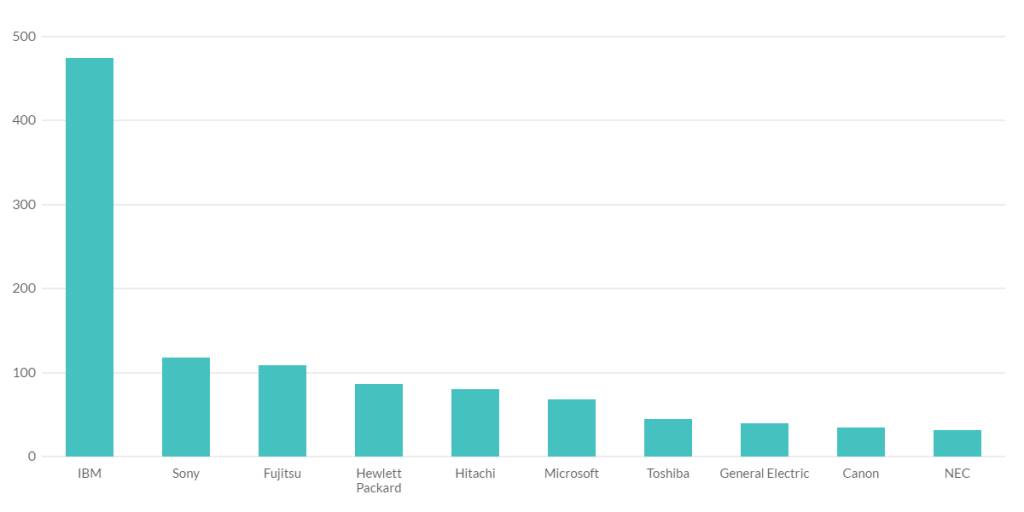Dow Chemical Co. (Dow) sued Nova Chemicals Corp. (Nova) for patent infringement in 2010, arguing that Nova’s polyethylene plastic products infringed Dow’s patent.
Dow Chemical won its case in an Ontario court in 2017 and then at an appeals court, receiving a CAD 645 million ($482 million) infringement award. The award was among the biggest offered in Canada.
The cases illustrate the critical step in ensuring the smooth commercialization of a product is conducting a Freedom to Operate (FTO) search.
This blog post highlights the importance of FTO searches, detailing a case study to illustrate how early and thorough patent analysis can prevent costly mistakes and enhance product development.
Understanding the FTO Search Process
Conducting an FTO search at the early stages of product development helps companies identify potential infringement barriers and increase their ROI. This case study highlights how we conducted an FTO search for a coffee capsule piercing module, revealing the importance of considering both active and inactive patents.
Key Features of the Coffee Capsule Piercing Module
The client’s product had two primary features:
- Key Feature 1 (KF1): A base plate/disc with protrusions for piercing the first surface of the capsule.
- Key Feature 2 (KF2): At least one tooth at the top of the module for puncturing a second surface of the capsule.
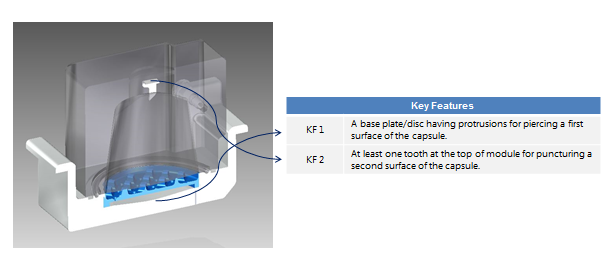
The FTO Search Approach
The primary goal of this FTO Search project was to identify potential threats to the product and provide a clear risk assessment. Our approach began with a detailed understanding of the technology.
After establishing a thorough understanding, we initiated our search by considering key features individually and making all possible relevant combinations of sub-key features in a pre-decided timeline. In other words, we targeted both active and inactive patents, but the primary target was alive/active patents that claimed the given features of the product.
Risk Matrix and Its Objective
We prepared a risk matrix to offer a bird’s eye view of patents that needed attention and the associated risk levels. The matrix categorized patents based on their relevance and ownership, helping the client prioritize their focus.
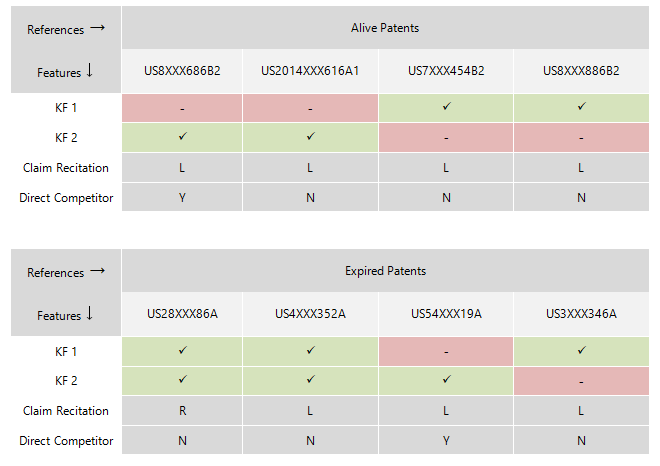
- R (High Risk): Indicates that the claim fully recites the key features, posing a higher risk.
- L (Low Risk): Indicates that the claim recites the key features but includes additional limitations or different features, posing a lower risk.
- Y (Competitor-Owned): Denotes patents owned by direct competitors, which can carry more risk if they are active.
This matrix is an invaluable tool for patent counsels and R&D heads. It enables them to identify patents requiring more attention, such as those owned by direct competitors, and fully recite key features. Additionally, patents with limitations (L type) need to be considered, as these limitations might be general or obvious and inevitably become part of the product.
The matrix also incorporates expired patents, which help determine which features are free to use and which can be leveraged to challenge the validity of risky patents. This matrix offers a holistic view of risks, threat levels, and mitigation options.
Technology Timeline and Its Purpose
To understand the technological evolution, we analyzed patents from 1950 to 2014, dividing this timeline into two periods. This analysis highlighted shifts in technological advancements and identified expired patents that are free to use.
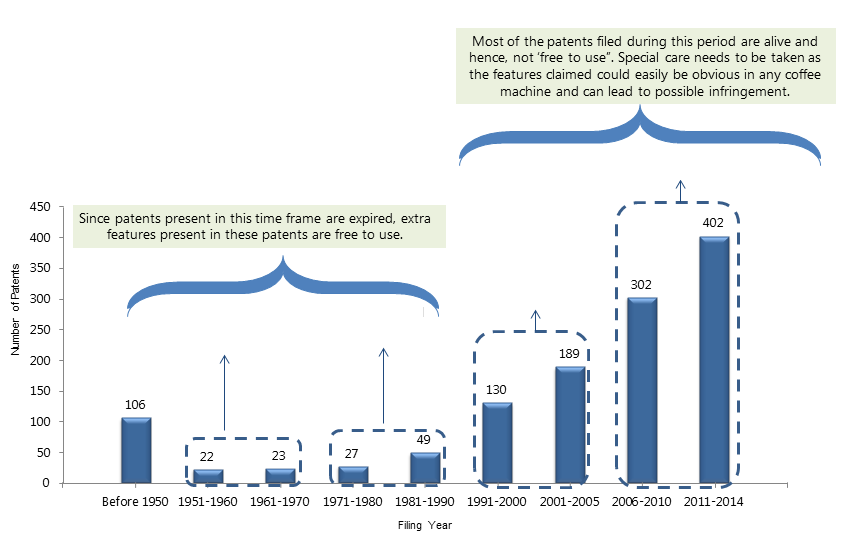
We examined relevant patents and found that the product’s key features were broad. Consequently, we focused on expired patents, looking for all possible features (and their combinations) that could be incorporated into the product without infringement risk. We also monitored patents expected to expire before the product launch.
Highlighted Key Features with Limited or No Patent Claim Overlap
We provided two fields in our report: “overlapping features” and “extra features.” The “extra features” column listed features from free-to-use patents. These additional features from inactive patents can help companies enhance their products without patent risks.
Free-to-Use Features
Patents from 1950 to 1990 were expired, making their features free to use:
- 1950 to 1970: 45 patents included KF1 and KF2, along with extra features like water inlets and nested disks for piercing the pellet.
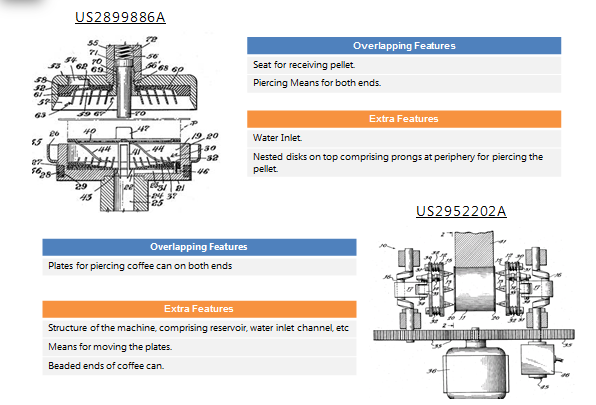
- 1971 to 1990: 76 patents included KF1 and KF2, with additional features like means for moving the piercing plate and multiple capsules within the machine.
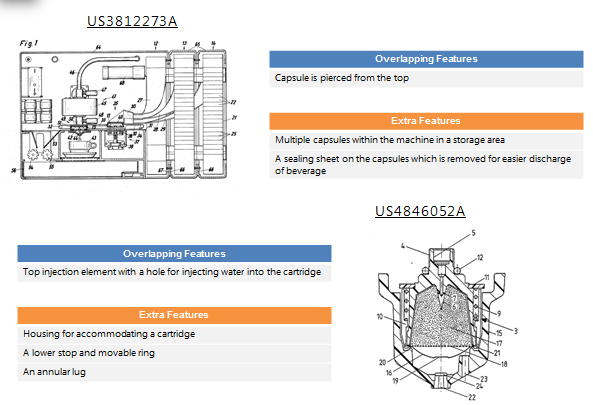
This information is crucial as it helps R&D teams evolve their products from various directions, leading to more effective products with lower risks. If there are any active patents based on these features, expired patents can be used to challenge their validity or negotiate licensing terms, thus reducing overall risk and costs.
Future Free-to-Use Patents
Most patents filed between 1990 and 2014 were active and not free to use. However, some of these patents will expire in a few years, allowing the technology to become public. Considering the product launch timeline of approximately 3-5 years, features from these patents can be added when the product is launched.
A Threat to the Client’s Product
During our search, we carefully examined patents as their claimed features could be obvious in any coffee machine, leading to potential infringement:
- 1991 to 2005: 309 patents disclosed KF1 or KF2, along with extra features like a holding member and elongated slits.
- 2006 to 2014: 704 patents had more advanced features, such as extraction using centrifugal force and a disengaging device for the capsule.
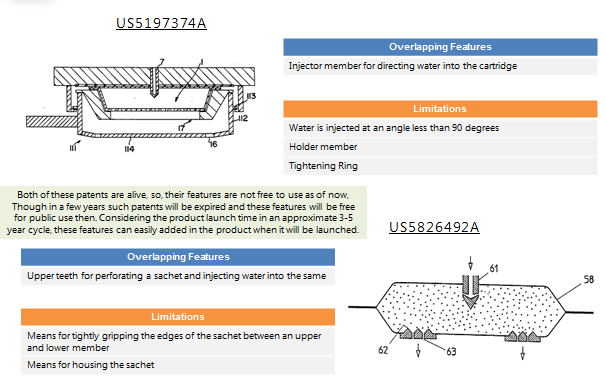
Based on our experience, figuring out such limitations is very important in the early stages of the product lifecycle. First, since these features are available in the active patents, they are mostly more advanced than the features in the expired patents.
Secondly, knowing these features in the early stages can help in the 360-degree shaping of the product. Particularly, IP counsels and R&D heads evaluate these features to see if any of them can have a great impact on the product or its market. They try to think of alternative ways (not claimed in any patent) to create the same effect. They try to include such features in their product if they find any such way.
This would help them include all the required features while avoiding all the risks, and alongside, include some advanced features that can improve the overall future potential of the product.
Competitor Activities
In addition to identifying patents that could threaten our client’s product, we provided a detailed patent filing trend graph. This graph illustrates the evolution of patent filings over a specific timeline, helping our client understand how their competitors have shaped their IP strategies.
For instance, in the case discussed, the chart reveals how various companies, particularly Nestlé, developed their patents and focused on different technologies over time.
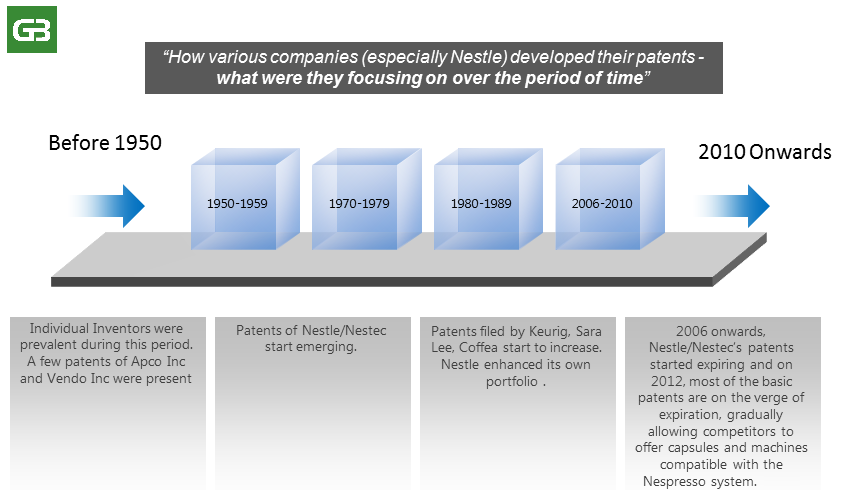
Our analysis showed that Nestlé has two types of coffee machines – ‘OriginalLine’ and ‘VertuoLine.’ The latter, a newer line from Nestec, employs centrifusion technology, a combination of centrifugal action and water infusion, to spin the capsule around the machine at up to 7,000 RPMs. This advanced feature of “centrifusion brewing” could open new directions for innovation in coffee piercing technology.
The Role of Competitor Information in FTO Search
Understanding competitor activities is crucial in an FTO search. The FTO study may uncover patents that require licensing to commercialize the technology without infringement issues. While startups or individual inventors own some patents and can be licensed at reasonable terms, others may be held by direct competitors and may not be available for licensing.
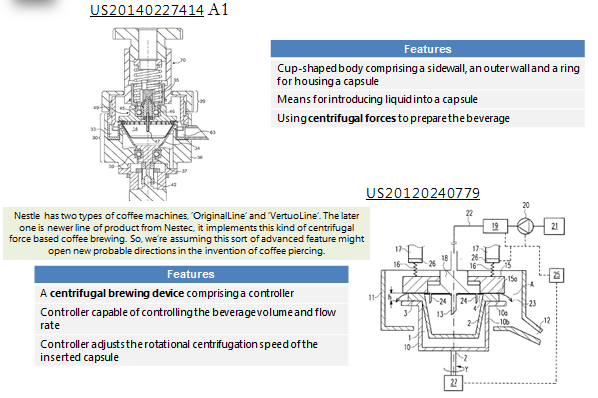
These competitor-held patents can become significant obstacles in your product launch. Knowing your competitor’s patent activities and product developments can be invaluable. By identifying the technologies, your competitors are working on or have patented, an FTO study can highlight patents of interest to both you and your competitors but held by third parties who may be willing to sell. Acquiring these patents can facilitate reasonable terms with your competitors and enable cross-licensing arrangements, mitigating the overall risk of patent infringement.
During our FTO search, we identified several features present in different claims that seemed obvious for any coffee-piercing machine. We also pinpointed advanced features that could be integrated into the product or around which the product could be designed.
Final Analysis and Insights
Ultimately, we presented a detailed analysis of all shortlisted patents and insights as the final output, providing our client with a comprehensive understanding of the patent landscape and actionable strategies for mitigating risks.
Conclusion
Traditional FTO searches focus solely on live patents due to their legal threats. However, we believe a patent counsel’s role extends beyond risk management to value creation. By including insights and identifying free-to-use features, we provide additional ammunition to the product development team.
Our approach involves plotting the technology timeline, and categorizing scouted patents into multiple categories, such as future, past, and free, while sharing competitor activities. This helps identify patent threats and adds free-to-use features to the product. Our goal is to deliver high ROI and maximum value to our clients.
For further insights on conducting effective FTO searches, you can explore our other detailed articles on GreyB’s blog:
- Why FTO Searches Are Crucial for Product Development
- How to Perform a Comprehensive FTO Search
- The Importance of Including Expired Patents in FTO Searches
Maximize the value of your patent searches and ensure a smooth product launch.
Fill out the form below to discuss your project and discover how our comprehensive FTO search services can provide you with a high ROI.
Authored by: Nikhil Gupta, Assistant Vice President GreyB
Edited by: Annie Sharma










